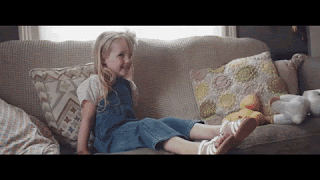Analysis of Jamie Lawson's 'Wasn't Expecting That'
The concept behind the music video is that it starts at the end of the couple's story and traces backwards from there through their whole lives up to the moment they first met, before switching back to the end. This is why the music video would be referred to as having a palindromic structure.
The music video uses colour grading and a letterboxed aspect ratio to make it look more cinematic; mainly because the video doesn't only come under the concept music video type but also the narrative. The video tells the story of these two people's lives. We see the hardships that they faced and the good things that they experienced. The video is very human, it doesn't idolize what real life is actually like, instead painting an almost picture perfect painting of the lives of 'normal' people.
The camera techniques used in the video aim to make the video seem like that of a 'family-video', the camera is often not pristinely smooth or straight; it is often canted and shaky. The first shot is an extreme close up of the male characters face; which presents the raw emotion and humanity of the old man. We don't know why he is sad, which leaves a narrative hook for the audience to continue watching. The video uses a lot of close-ups; mainly to show the emotion the characters are feeling (as this is the main point of this music video). These close-ups often focus on the two characters together and tend to show similarities throughout the video (for example, the way the wedding car scene is framed is extremely similar to that of their first kiss (shown below)).
One aspect of editing that this video succeeds greatly on is the transitions between scenes. As the narrative portrays a fast paced change in time (years in minutes) the editing has to match this. In order to do that smoothly it uses visual staples to aid transitions and, during the start of the video, it uses fades to darkness to transition between the scenes (because the start of the video is the saddest part, the lighting is shown to be much lower key). These fades allow for slow transition between the different scenes and the lighting allows for a sense of mystery; we can't quite tell whether what we are watching is sad or that these are the last happy moments of the couple that are now shrouded in darkness due to the wife's death.
As the video progresses, the lighting turns to that of a higher key; to reflect that the scenes we are watching are the happiest memories the husband has of his, his wife's and their children's lives. The transitions also change, at one point they use the falling of a duvet cover over the camera to signify a change and elsewhere (as mentioned before) they focus on a set point or use a camera pan/movement to transition between scenes. In the example below, we see the camera move from being focused on the child as a toddler, to the parents trying to entertain the child and then back to the child as a baby. This transition reflects the path of time, showing also that the parents attitude to their children never really changed (no matter their age).
Mise-En-Scene is also a really effective part of this video. Due to the fact that it is showing the passing of time through different decades, costume had to be changed to suit the time period. Also, as shown in the GIF below, some of the costumes transitioned with the characters; showing that they are the same people even though they look really different. The costumes that they use are normally just casual wear but they also used things like suits, 'hippy' clothing and school uniform. I have already mentioned how the lighting changes to reflect the mood of the scene (where sadder scenes are shown as darker). The location of the music video is mostly at the couple's home, once again connoting how the video is like a home video, but also showing the hard reality that most of our lives are spent inside one place.
The video applies Andrew Goodwin's Music Video Theory, but in a kind of convoluted way. Part of his theory suggests that the visuals on screen match the lyrics. 'Wasn't Expecting That' somewhat applies this hypothesis in that the lyrics at the start of the song match those at the end of the video itself; 'it was only a smile' refers to the first time that the two met (which is shown in the last seconds of the video). Then, the ending of the song matches the beginning of the video; 'three kids up and gone' refers to how the kids have grown up and moved away (which is shown in the video). Basically, due to the concept of the music video, the theory is displaced chronologically but still somewhat applies to the overall lyrics and visuals. The very end of the music video matches the lyrics; 'when you closed your eyes, you took my heart by surprise', as the mother finally passes away. Another part of the theory that is applied here is that the visuals match the music itself; which is correct due to the fact when the speed of the music increases, as does the speed and lighting used in the clips.
Overall, as I said at the beginning, Jamie Lawson's 'Wasn't Expecting That' blended a variety of cinematic tropes and music video conventions to create one of the most empowering videos I have ever seen. This is the standard that everyone who creates videos should be aiming for, ourselves included.






Comments
Post a Comment